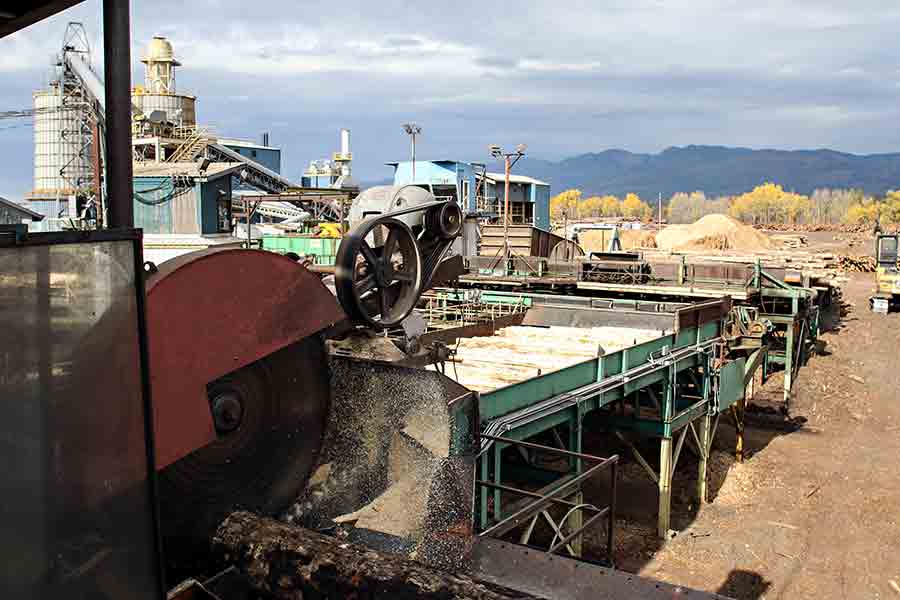Manufacturing Industry Sees Significant Earnings Growth
A recent report reveals the wood products and food-and-beverage sectors are experiencing some of the highest earnings in Montana as the state outpaces the nation’s manufacturing growth
By Maggie Dresser
Montana’s manufacturing industry grew significantly in 2021, rebounding after a pandemic-fueled economic slowdown and totaling $1.6 billion in private state earnings last year, according to a Montana Bureau of Business and Economic Research (BBER) report released earlier this month.
While petroleum remains the leading industry in Montana, accounting for 58.5% of total manufacturing earnings, wood products were the second-highest earnings sector in 2021 with $133 million. Food, beverage and tobacco industries rose 10.7% in earnings since 2019, which experts attribute to a slew of new breweries, wineries and distilleries that opened across the state.
In the wood products industry, the average price per thousand board feet (MBF) for Douglas-fir in western Montana last year in the second quarter was $481 compared to $393 in 2019. Prices rose dramatically since the pandemic began while harvests in Flathead County totaled to 60,636 acres in 2021 compared to 36,362 acres in 2019, according to BBER data.
Compared to nationwide trends, Montana has outpaced the United States and is 50% larger today than it was in 2010 while the rest of the nation grew by about 22%.
“Montana manufacturers have shown tremendous resilience over the last two years,” said Paddy Fleming, the director of the Montana Manufacturing Extension Center. “They not only survived the pandemic, but many of them found innovative ways to grow and prosper. Manufacturing represents a significant and growing contributor to Montana’s economy.”
The report analyzed survey data from 90 companies during 2021, and authors describe Montana’s recovery from the COVID recession as “robust,” with real gross domestic product (GDP) returned to pre-pandemic trends in the first quarter of 2021.
Employment also made a full recovery since the height of the pandemic and the state attracted 20,000 new residents and workers in 2021, according to the report.
As the fastest-growing county in the state, Flathead County added 3,681 people between July 1, 2020, and July 1, 2021, according to Census Bureau data. The population growth added to the workforce and manufacturing employment, while output growth was more than double the national average for two years in a row.
According to the report, the population growth brought a “more skilled” workforce to Montana, increasing productivity and incomes. Data reveals that manufacturing jobs paid about $57,000 in earnings compared to the state average of just under $51,000.
Applied Materials, a semiconductor-plating manufacturer, added a third facility in the Flathead Valley this year, bringing 200 new jobs to the region with positions ranging from manufacturers to engineers.
“The demand has never been greater (for microchips),” Dennis McHaffie, the vice president of business operations for Applied Materials said earlier this year. “We can’t ship them fast enough – we’re having all of the right problems.”
Also new this year, Jerimiah Johnson Brewing Company opened in the 15,000 square-foot Blackstar building in downtown Whitefish, which has four 100-barrel, 23-foot-high fermentation tanks and two kitchens. While the beer production at the new brewery was not included in the survey, it illustrates another example of the growth in the food and beverage industry in the Flathead Valley.
The pandemic and the war in Ukraine caused supply chain disruptions in the past few years, affecting both goods and services. According to surveys, the primary issues impacting manufacturing plants was availability or cost of raw materials, followed by transport and supply chain problems.
Looking forward, economists with BBER expect Montana manufacturing earnings to grow at a relatively consistent rate through 2025; output and employment is also expected to grow, but will likely experience more ups and downs, the economists say.